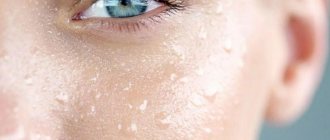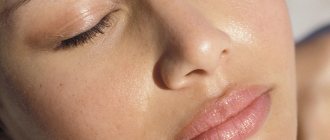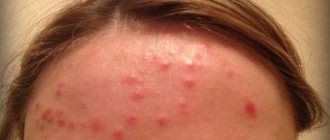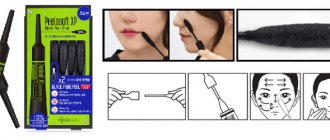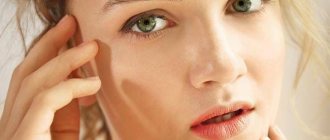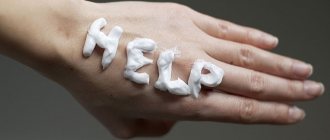How to apply eye shadow so that it doesn’t fall off and lasts a long time?
Many girls do not use eyeshadow palettes because they are afraid that complex makeup will look sloppy, and their eyes will look tired, and that the shadows will emphasize dark circles under the eyes.
Irina explained the main rules for applying eye shadow :
- Apply concealer to the area around the eyes and be sure to tint the eyelids. Your task is to prepare a “clean slate”, that is, to remove all redness and unevenness around the eyes. After tinting, we also powder the eyelids, and then any shadows will fit perfectly.
- For those whose shadows roll or crumble, Irina suggests using an eyeshadow base or cream eyeshadow . These shadows are very popular and easy to use: you can apply them with your fingers or a brush, shading upward into the crease of the eyelid. They also come in matte, satin, and glitter. If your eyelid is drooping, you shouldn’t choose shiny shadows; it’s better to choose satin or semi-satin ones - they have shimmer that gives a delicate shine. It is very important to apply cream shadows evenly, in a thin layer, to avoid shedding.
- Don't forget to paint the space between eyelashes . If you want to enlarge your eyes, you apply dark shades to the upper mucosa, and light shades (beige-pink) to the lower mucosa.
- If you want to make a bright color accent on your eyes, then shade the shade on the lower eyelid .
- Do not forget to carefully paint the eyelashes as much as possible from the root to the top. To curl your eyelashes, lift them with your finger while the mascara is still wet and hold it there for a few seconds. If you want to create a slightly cat-like look, then try to move them a little to the side.
- In addition, remember that in order for the makeup to look harmonious, if you paint over the shadows below, then tint the lower eyelashes , as they also add shadow and volume to the eyes.
Oily skin stings eyes. Symptoms of the disease and what they lead to
Normally, the eyelids are the driest area of the face. There are practically no sweat and sebaceous glands in them. Therefore, when the eye area begins to sweat, it “knocks you out of the saddle.” There are three main symptoms. This is constant discomfort, the eyes sting, as if something had gotten into them, and severe itching.
And finally, hyperhidrosis of the eyelids itself is their increased sweating. The sensation can be compared to the constant contact of foreign objects such as dust particles in the eyes.
Due to the fact that this problem occurs - sweating under and above the eyes - you may experience such inconveniences as:
- Oily, sweaty eyelids make it difficult to see properly.
- For women who wear makeup, it leads to smearing. If a lady also has unwashed hair, the woman’s appearance suffers greatly.
- Sweating eyelids negatively affects the likelihood of wrinkles.
- Rubbing the eyelids. Sweat came out and got into my eyes.
- Their redness from constant scratching.
To prevent this from happening, you need to start fighting hyperhidrosis of the eyelids and upper half of the face as early as possible, but first you need to find out what the cause of sweat under the eyes is. Often it is a change in hormonal levels. Eyes often begin to sweat during pregnancy, during PMS or menopause.
In this case, eye cosmetics are contraindicated for you, at least the ones you use: if they come into contact with the upper eyelids, hyperhidrosis may begin. Change your makeup or give it up altogether. This also includes the use of certain hormonal drugs, such as Cortisone and its derivatives.
What should the shadows be like?
When going shopping at an online cosmetics store or an offline store, remember that it is better to give preference to eyeshadows with a waterproof formula.
Don't forget about texture. In terms of durability, cream shadows are inferior to dry ones, although the ease of application and comfort on the skin of cream textures for many exceed the problem of creasing on the eyelids.
As already mentioned, the quality of cosmetics is important. Pay attention to the composition of the shadows, especially if your eyelids are prone to oiliness. In this case, it is worth purchasing shadows designed specifically for this skin type.
How to apply eyeshadow yourself
So, in order for the image to be harmonious, you need to decide what type of makeup is needed. It could be;
- casual look,
- evening,
- festive,
- business,
- wedding,
- makeup in nude style.
It is necessary to have all the necessary tools at hand. First of all, you need brushes of different sizes, each with its own purpose:
- The brush can be flat, it is needed for application.
- The barrel brush is used for shading and for drawing the crease of the eyelid.
- A thick brush is needed to soften the lines.
- Using an angled brush, soft arrows are obtained.
Makeup brush set
Blepharoplasty is the most effective way
The fastest and most effective method to remove sagging skin above the eyes is plastic surgery. Eyelid surgery is called blepharoplasty; it allows you to get long-lasting, sometimes permanent results.
The main indications for blepharoplasty (lower and upper) are:
- sagging skin of the upper eyelid;
- "aging eyelid";
- tired look (“heavy eyelids”);
- bags under the eyes;
- excess skin of the lower eyelids.
With the help of eyelid surgery, the following problems can be solved:
- get rid of excess skin and fat around the eyes;
- tighten the muscles in the area around the eye orbit;
- reduce the consequences of age-related changes;
- eliminate eyelid defects and change the shape and shape of the eyes.
Thus, upper eyelid blepharoplasty eliminates excess skin hanging over the eyes. This type of surgery is usually performed through a skin incision along the crease of the upper eyelid, through which excess fat and skin are removed.
Although the operation is quite simple for an experienced plastic surgeon, there are a number of contraindications and negative consequences that you should be aware of before removing drooping eyelids using surgery.
Blepharopoastics can remove drooping eyelids and change the shape and shape of the eyes.
Surgery is contraindicated for people with thyroid problems, diabetes and cardiovascular disease. They should consider options for how to remove drooping eyelids at home without surgery.
In addition, after blepharoplasty, the shape of the eyes may look unnatural due to the effect of stretched skin.
What to do to prevent shadows from rolling?
- Be sure to prepare your eyelid - apply primer. The primer can be matte, with shimmer particles, or even completely transparent.
- Lightly powder the primer itself, or apply a thin layer of nude shadows. This will make it easier for you to further shade and prevent the shadows from sticking; they will be applied more evenly.
- If you don't have a special primer, it's okay. Apply a layer of regular concealer evenly over your eyelids and lightly powder it. The effect will be the same. An important point: do not use a moisturizing concealer for this purpose, the effect may be the opposite.
- Apply a thin layer of eyeshadow. Firstly, a thick layer is prone to sticking and rolling, and secondly, it can also visually age the eyes and emphasize wrinkles. Agree, the profit is very doubtful.
- If you are planning a makeup with cream shadows, be sure to set them on top with powder ones. Even if your cream shadows are self-fixing. Setting any cream products with powder is a must.
- If you want 100% durability, then fix your makeup with a fixative spray at the very end of its creation. This will also reduce the likelihood of rolling.
Treatment and care
Since the problem of oily eyelids can be caused by a variety of factors, it is important to accurately determine the cause in order to choose the appropriate treatment.
If this problem accompanies you almost all day, it would be best to see an ophthalmologist.
Sometimes you need to undergo skin tests to determine the correct treatment.
What to do?
By following these simple tips, you can apply makeup without worrying about the problem of sticky eyelids.
Before applying makeup
Before applying fresh makeup in the morning, make sure that there are no remnants of yesterday's cosmetics on your skin.
"You should make sure your skin is thoroughly cleansed of makeup and oils because this can increase the oiliness of your eyelids." [Www.refinery29.uk]
Always use cosmetics such as mascaras, eye shadow and eyeliner with soft applicators. Apply makeup to fresh, clean and dry eyelids
Regular face washing and skin care treatments
Wash your face with cleansers containing salicylic acid or alpha hydroxyl acids such as glycolic acid, which reduce oil production.
Cleanse your face thoroughly every morning and before bed. Remove sebum from the surface of the skin with a mild, foaming cleanser. Close your eyes and rub them lightly, then rinse off the cleanser. Pat your face and eyes dry with a clean towel.
Avoid getting creams directly on the eyelid
If you have visited a specialist for treatment and the problem persists, return and continue treatment.
Try not to apply creams on the eyelids or very close to the lash line. The emollient properties of moisturizing eye creams will lead to the destruction of makeup.
IMPORTANT : Always use oil-free moisturizers and gels, they will not separate and remain on the eyelids.
Use a proven primer
A primer is a cream or lotion applied before applying makeup to improve coverage and lengthen the time the makeup stays on the face. An oil-free base is necessary to prevent makeup from smearing.
Prep your eyelids with an eye primer that will make your skin look smoother, matte and ensure your makeup stays in contact.
Eyelid primers also prevent creasing and can reduce oiliness.
What to do to prevent shadows from rolling?
- Be sure to prepare your eyelid - apply primer. The primer can be matte, with shimmer particles, or even completely transparent.
- Apply the primer in an extremely thin layer and distribute it well with the pad of your ring finger. Make sure that there are no exact boundaries for applying the primer - after applying the shadows this will be very noticeable.
- Lightly powder the primer itself, or apply a thin layer of nude shadows. This will make it easier for you to further shade and prevent the shadows from sticking; they will be applied more evenly.
- If you don't have a special primer, it's okay. Apply a layer of regular concealer evenly over your eyelids and lightly powder it. The effect will be the same. An important point: do not use a moisturizing concealer for this purpose, the effect may be the opposite.
- Apply a thin layer of eyeshadow. Firstly, a thick layer is prone to sticking and rolling, and secondly, it can also visually age the eyes and emphasize wrinkles. Agree, the profit is very doubtful.
- If you are planning a makeup with cream shadows, be sure to set them on top with powder ones. Even if your cream shadows are self-fixing. Setting any cream products with powder is a must.
- If you want 100% durability, then fix your makeup with a fixative spray at the very end of its creation. This will also reduce the likelihood of rolling.
Eyelid hygiene. Health and beauty of your eyes.
Over time, more and more self-care habits and daily rituals have become part of our daily routine.
Cotton swabs, a toothbrush, soap, wet wipes and the same antiseptic hand gel have long become an integral part of personal hygiene.
For any habit to become a part of your life, it is enough to remind yourself to do something every day for 2 to 4 weeks, and after a month - voila, you won’t notice how your hands reach out to do what is necessary without a reminder - especially when the first result is already visible.
Everyone knows perfectly well that neglecting oral hygiene can have extremely depressing consequences - both for health and for the wallet.
No less important organs that require care are your eyes
.
Of course, there is a nuance - toothache is an extremely unpleasant phenomenon, sometimes unbearable. If something irreparable happens, your body will not let you delay for more than a few days and will sound the alarm with severe acute pain.
As for the eyes
– here the situation is completely different – the body does not scream for help, but only quietly asks for it. When you feel dryness, burning in your eyes, or vice versa - tears flow in a stream, although there is no reason for this - this is a sure sign that it is time to start acting.
Why do such problems arise and why is humanity thinking about this only now?
Oddly enough, technological progress that has accelerated in recent years is to blame for everything. 20 years ago, a mobile phone, computers at home and in the workplace were rather something surprising, and as a result, people’s eyes turned to screens only in the evenings, and even then not for long. Now it will be more difficult to calculate the amount of time spent without riveted attention to a monitor or gadget. The iPhone, for example, provides detailed statistics on how much time you use it weekly - you must agree, the number there is clearly two-digit. Add to this a work laptop, advertising monitors in supermarkets and transport, and it’s good if the total number of hours remains within a hundred.
No, the reason here does not lie in grandma’s parting words that you will “break your eyes” from sitting too close in front of the screen, but she was partly right. It's all about the frequency of blinking - in a normal state, for example, during a leisurely walk, you blink 10-15 times per minute (and you don't even notice it). Your eyes are comfortable and relaxed. However, it’s worth focusing on the image on the screen (this is how human attention works) - and you already blink at a frequency 3-5 times less often. Next comes a simple logical chain - you began to blink less, the membrane of the eye began to moisten less and less frequently, the eye glands responsible for this process (meibomian) began to work worse as unnecessary, and a stagnant secretion began to form in them.
The sad consequence in the future is precisely those sensations of cutting, burning, dryness of the eye,
and, over time, if nothing is done, they will only get worse. Or maybe it’s completely the opposite - towards the end of the working day, tears flow every now and then, although no one offended you. This is a sure sign that your body is desperate to get help and has turned on an emergency rescue in the form of the lacrimal glands. You can't remain idle any longer!
No matter how much you want, neither the climate nor the economic component of modern life will allow you to give up everything and go live in a forest belt, away from all kinds of radiation and screens.
If we cannot change the original harmful conditions for the eyes, what can be done?
Firstly
, take the problem seriously and stop avoiding it.
Secondly,
Get into the habit of visiting an ophthalmologist at least once a year. And finally, thirdly, start caring for your eyes daily by performing hygiene procedures for the eyelids; it will not take you more than 5-7 minutes.
What do we have to do? Everything is very simple.
First you need to clean your eyelids. We are talking not only about washing off makeup before going to bed - we are talking about high-quality cleansing of microparticles of dust and lint from clothes worn over the head. A product with non-aggressive surfactants is suitable for this.
, which was specially developed for thin and sensitive eyelid skin. This stage is a necessary foundation for subsequent steps; it should not be neglected.
The second stage of the hygiene procedure is warm compresses
.
Why is this so important? As mentioned earlier, to restore the function of the glands, it is necessary to remove the stagnant secretion from them, and this requires a certain temperature - not lower than 35-40 degrees. blepharo napkin
for this . And here again I may remember the same grandmother who applied tea bags. The process of temperature exposure is, yes, similar, but a tea bag is not at all about hygiene, and besides, it will greatly dry out the thin skin of the eyelids, as, by the way, does alcohol. By the way, this napkin is sterile precisely due to the sterile production process. It is enough to hold the warm compress for about 5 minutes and lightly wipe the eyes and eyelid area with a napkin.
And the final step is the therapeutic care product Blefarogel
1
. It is thanks to him that the affected skin of the eyelids will become tightened and fresh again, and the meibomian glands will begin to function properly again. And all that is needed for this is to apply a drop of gel to a clean fingertip and rub it in with massage movements until completely absorbed - in the direction “from the nose” - the upper eyelid, “towards the nose” - the lower one.
The key to the success of any procedure is regularity. You should not count on a lightning-fast solution to the problem; for a full effect, you need 1-2 months of daily care. In general, if this becomes your good habit, you will literally be able to see its effectiveness.
Be healthy!
THERE ARE CONTRAINDICATIONS, YOU MUST READ THE INSTRUCTIONS OR CONSULT WITH A SPECIALIST.
Common mistakes and how to avoid them
- Darkening the outer part of the moving eyelid - you should darken the inner part of the moving eyelid and lighten the outer part to visually balance their size.
- Noticeable arrows - with drooping eyelids, clear lines of arrows do not decorate the eyes, but make them narrow. There is also no need to bring out the ends that go beyond the corners.
Lack of shading or insufficient shading - a sharp outline looks very unnatural, but you just need to shade the tone and you immediately get a soft and pleasant makeup.
Continuous eyeliner along the entire contour of the eyes - because of such eyeliner, the eyes look like slits, and the look becomes unnatural and flat. Gray-black shadows and smoky makeup can play a bad joke on owners of drooping eyelids, making their eyes even more sunken
Smokey eyes with drooping eyelids should be used very carefully, especially if you have light eyes. It is better to stick to medium-saturated shadows in gray-brown and ashy shades.
Sticky eyelids. Possible diseases
By the nature of the discharge, one can determine the disease of the visual organ. Periodically appearing white discharge from the eyes in the morning, not accompanied by signs of inflammation, is normal. If they become regular and other complaints appear, then the development of an ophthalmological disease is likely.
- White mucous discharge from the eyes is characteristic of viral diseases (viral conjunctivitis), and is possible after an acute respiratory viral infection. Additionally, redness of the mucous membrane and sclera, lacrimation, photophobia, swelling, as well as signs of a cold (coughing, sneezing, elevated body temperature) are noted. When the virus first affects one visual organ, then the second one joins.
- Another reason is dry eye syndrome. It manifests itself as dryness and fatigue of the visual organ. Occurs after prolonged hard work at the computer or with small objects.
- Liquid transparent. This is a sign of an allergy (allergic conjunctivitis). The defeat is two-sided. Accompanied by severe itching. The eyelids turn red and swell. After eliminating the allergen, the symptoms subside.
- Transparent liquid discharge is possible when dust or foreign bodies enter the discharge. It is a protective reaction of the body. The goal is to remove foreign particles mechanically.
- Yellow abundant. Appear due to inflammation of the lacrimal sac - dacryocystitis. The discharge is copious and thick. It intensifies when massaging the affected area.
- Greenish or yellowish foamy discharge is most often found with blepharitis, an inflammation of the eyelid. Accompanied by itching, peeling, swelling of the eyelids. The discharge from the eyes is sticky, accumulates in the morning, sticks together the eyelashes, and forms dense scales and crusts. Other causes are eye infections, a reaction to a dust mite.
- Thick yellow, green with a gray or brown tint is a sign of inflammation, formed due to the accumulation of leukocytes. Characteristic of bacterial conjunctivitis, viral and fungal infections of the cornea, trachoma, opening of barley. Additionally, there is the formation of dense crusts that are difficult to remove. A film forms on the eye, which interferes with the clarity of vision. There are redness, swelling, lacrimation, and photophobia. In severe cases - pain in the eyeball, headache, increased body temperature.
- Thread-like discharge is characteristic of filamentous keratitis. This is a disease that occurs when the function of the lacrimal glands is reduced. It manifests itself as dryness, burning, thread-like discharge, redness of the sclera. Leads to dystrophic changes in the cornea.
What is an eye shadow base?
Eyeshadow foundation or eye primer is an indispensable beauty product. It makes makeup truly lasting and expressive. Features a special formula. At the same time, it facilitates easier blending of dry and cream products. And increases the degree of their color rendition. However, simplifying make-up is not the only function of the primer.
Eyeshadow base is the basic component of makeup. It must be applied to the skin of the eyelids before applying decorative cosmetics. It is usually a translucent substance with a liquid consistency.
Sold in three types:
- In liquid form;
- In the form of a cream;
- In the form of a gel.
It is this makeup base that will add brightness to the shadows. At the same time, it will not allow them to roll off. And your makeup will remain in its original form for the whole day. Interestingly, it does not have to be corrected or repainted.
what to do if the shadows roll down due to oily eyelid skin?
The skin of your eyelids sometimes becomes oily, even if you have normal or combination skin type. However, this problem can be brought under control. When preparing for makeup, it is enough to degrease your eyelids by wiping them with a cotton pad and micellar water.
©Getty
Then go over your eyelids with cotton pads and water (to remove the micellar water), followed by a primer that mattifies the skin. For example, Eyeshadow Primer Potion from Urban Decay.
The coating will be matte, dry and “grassy”: the powdery texture of the shadows adheres perfectly to this base and lasts all day. You won’t even remember how oily your eyelids are.
Return to contents
Diagnostics
Patients with xanthelasma of the eyelids need to consult not only an ophthalmologist, but also an endocrinologist and a dermatologist. The examination must include a general blood test, a study of lipid metabolism (level of lipoproteins and cholesterol in the blood serum).
The characteristic appearance of the formations usually does not pose any difficulties in making a diagnosis. In addition to xanthelasmas and xanthomas, the patient is often diagnosed with obesity, hypertension, metabolic syndrome or diabetes mellitus. Xanthelasma of the eyelids must be differentiated from other similar skin diseases (syringoma, pseudoxanthoma), incl. malignant tumors.
